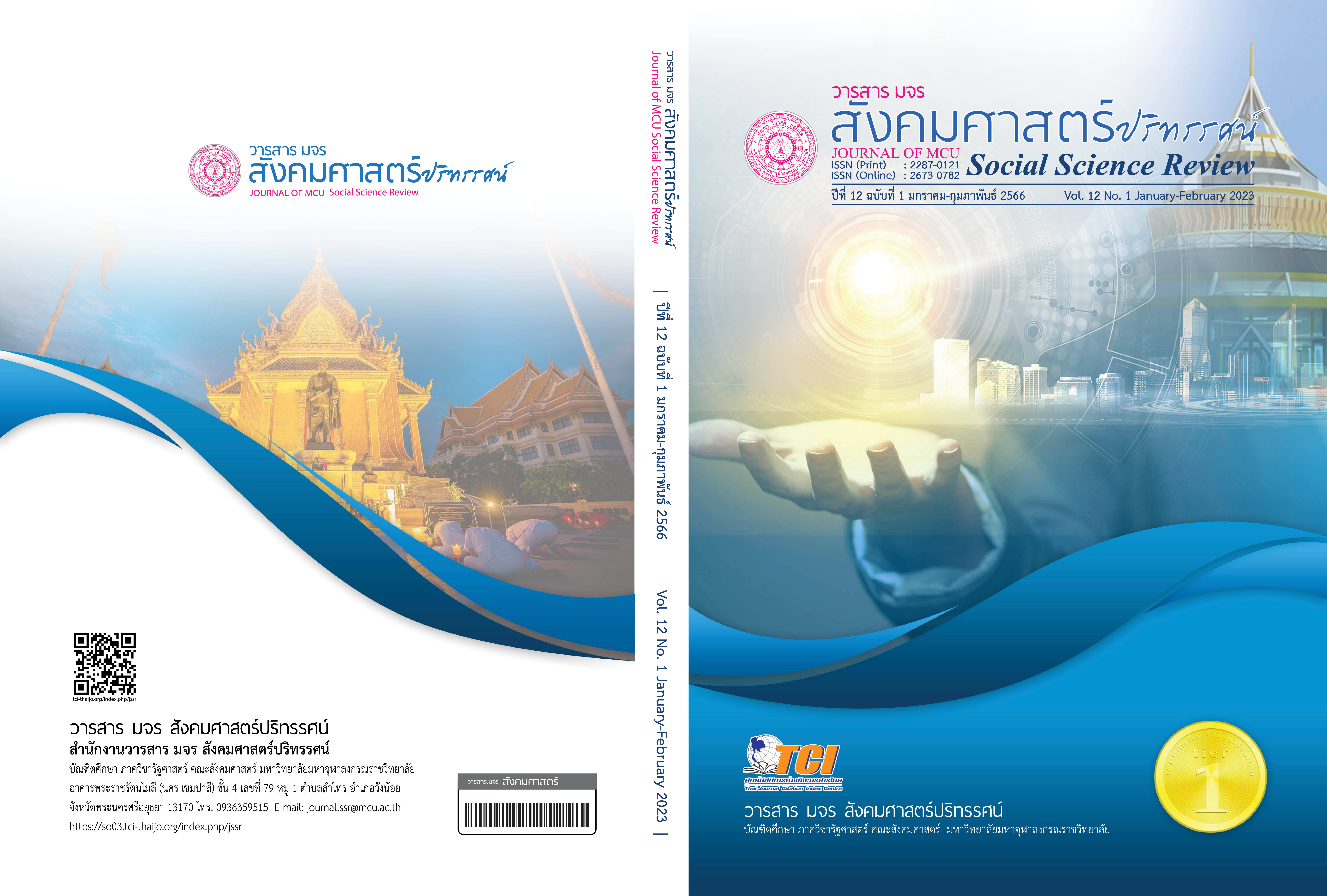รูปแบบการพัฒนาวัดตามแนว 5 ส. ในจังหวัดพระนครศรีอยุธยา
คำสำคัญ:
รูปแบบการพัฒนา, การพัฒนาวัด, กิจกรรม 5 ส.บทคัดย่อ
บทความวิจัยนี้มีวัตถุประสงค์ 1. เพื่อศึกษาสภาพทั่วไป 2. เพื่อศึกษาองค์ประกอบของการพัฒนาวัด และ 3. เพื่อนำเสนอรูปแบบการพัฒนาวัดตามแนว 5 ส. การวิจัยเป็นแบบผสานวิธี การวิจัยเชิงคุณภาพโดยสัมภาษณ์เชิงลึกกับผู้ให้จ้อมูลสำคัญ 22 รูปหรือคน และการสนทนากลุ่มเฉพาะกับผู้ทรงคุณวุฒิ 8 รูปหรือคน โดยเจาะจง วิเคราะห์ข้อมูลโดยการพรรณนาความ และการวิจัยเชิงปริมาณ ดำเนินการโดยศึกษากลุ่มตัวอย่างจำนวน 250 รูป จากพระภิกษุสงฆ์ในจังหวัดพระนครศรีอยุธยา เครื่องมือที่ใช้ในการเก็บรวมรวมข้อมูลคือแบบสอบถามสถิติที่ใช้ในการวิเคราะห์ข้อมูลได้แก่ ค่าความถี่ ค่าร้อยละค่าเฉลี่ย ส่วนเบี่ยงเบนมาตรฐาน
ผลการวิจัยพบว่า 1. สภาพการพัฒนาวัดตามแนว 5 ส. เป็นนโยบายสำคัญของคณะสงฆ์ มีหน่วยงานรัฐให้ความสนับสนุน ปัญหา อุปสรรค คือพระสังฆาธิการขาดความรู้ในการจัดการวัด ขาดงบและบุคลากร ในการดำเนินงาน 2. องค์ประกอบของการพัฒนาวัด คือ ควรสำรวจวัดและให้ชุมชนมามีส่วนร่วมในการวางแผนพัฒนาวัด สร้างเครือข่ายแลกเปลี่ยนความรู้ ติดตามผลงานการพัฒนาและบันทึกข้อมูลให้เป็นระบบ 3. รูปแบบการพัฒนาวัด ได้แก่ สะสางจัดแยกสิ่งของให้เป็นหมู่ ขจัดที่ไม่จำเป็นออก และจัดระเบียบการวางสิ่งของให้เป็นระเบียบเรียบร้อย ทำความสะอาดอยู่เสมอ รักษา 3 ส. แรกให้ถูกสุขลักษณะ มีอากาศถ่ายเท ไม่แพร่เชื้อโรค ควรรักษา 4 ส. แรกเป็นประจำ
เอกสารอ้างอิง
กองพุทธศาสนสถาน สำนักงานพระพุทธศาสนาแห่งชาติ (2551). คู่มือการประเมินมาตรฐานการพัฒนาวัด. กรุงเทพฯ: โรงพิมพ์สำนักงานพระพุทธศาสนาแห่งชาติ.
ครูสังฆรักษ์อนันต์ สุทฺธิมโน. (2564). การบริหารจัดการงานสาธารณูปการ ตามโครงการวัด ประชา รัฐ สร้างสุข ของคณะสงฆ์จังหวัดปทุมธานี (วิทยานิพนธ์พุทธศาสตรดุษฎีบัณฑิต สาขาวิชาการจัดการเชิงพุทธ). พระนครศรีอยุธยา: มหาวิทยาลัยมหาจุฬาลงกรณราชมหาวิทยาลัย
พระครูปลัดปรีชา จิรนาโค (บัวผัด). (2557). รูปแบบการจัดการสาธารณูปการของวัดในเขตปกครองคณะสงฆ์ภาค 14 (พุทธศาสตรดุษฎีบัณฑิต สาขาการจัดการเชิงพุทธ). พระนครศรีอยุธยา: มหาวิทยาลัยมหาจุฬาลงกรณราชมหาวิทยาลัย.
พระครูวินัยธรธรรมภณ ธมฺมพโล. (แก้วแจ่มศรี) (2558). การพัฒนาการจัดการศาสนสมบัติของวัดในจังหวัดพระนครศรีอยุธยา (วิทยานิพนธ์พุทธศาสตรดุษฎีบัณฑิต สาขาวิชาการจัดการเชิงพุทธ). พระนครศรีอยุธยา: มหาวิทยาลัยมหาจุฬาลงกรณราชมหาวิทยาลัย.
พระครูวิสิฐพัชราจาร (ไชยยา เขมสิริ). (2560). การพัฒนาการจัดการสาธารณูปการของพระสังฆาธิการจังหวัดเพชรบุรี (วิทยานิพนธ์พุทธศาสตรดุษฎีบัณฑิต สาขาวิชาการจัดการเชิงพุทธ). พระนครศรีอยุธยา: มหาวิทยาลัยมหาจุฬาลงกรณราชมหาวิทยาลัย.
พระครูสิริธรรมบัณฑิต (2564). รูปแบบการพัฒนาวัดด้วยวิถี 5 ส. โครงการวัด ประชา รัฐสร้างสุขของวัดมิ่งเมืองมูล. วารสารวิจัยวิชาการ. 4(1), 23-36.
พระมหาจินตวัฒน์ จารุวฑฺฒโน(วิจารณ์ปรีชา). (2562). รูปแบบการบริหารวัดสร้างสุขด้วยกิจกรรม 5 ส. จังหวัดสิงห์บุรี (วิทยานิพนธ์พุทธศาสตรดุษฎีบัณฑิต สาขาวิชาการจัดการเชิงพุทธ). พระนครศรีอยุธยา: มหาวิทยาลัยมหาจุฬาลงกรณราชมหาวิทยาลัย.
พระมหานพรักษ์ ขนฺติโสภโณ(นาเมือง). (2559). การบริหารจัดการวัดพัฒนาตัวอย่างในจังหวัดพระนครศรีอยุธยา (วิทยานิพนธ์พุทธศาสตรดุษฎีบัณฑิต สาขาวิชาการจัดการเชิงพุทธ). พระนครศรีอยุธยา: มหาวิทยาลัยมหาจุฬาลงกรณราชมหาวิทยาลัย.
Davis, et al. (1981). Human Behavior at Work: Organizational Behavior. (7th. Ed). (New York: McGraw – Hill Book Company.
ดาวน์โหลด
เผยแพร่แล้ว
รูปแบบการอ้างอิง
ฉบับ
ประเภทบทความ
สัญญาอนุญาต
ลิขสิทธิ์ (c) 2023 วารสาร มจร สังคมศาสตร์ปริทรรศน์

อนุญาตภายใต้เงื่อนไข Creative Commons Attribution-NonCommercial-NoDerivatives 4.0 International License.
เพื่อให้เป็นไปตามกฎหมายลิขสิทธิ์ ผู้นิพนธ์ทุกท่านต้องลงลายมือชื่อในแบบฟอร์มใบมอบลิขสิทธิ์บทความให้แก่วารสารฯ พร้อมกับบทความต้นฉบับที่ได้แก้ไขครั้งสุดท้าย นอกจากนี้ ผู้นิพนธ์ทุกท่านต้องยืนยันว่าบทความต้นฉบับที่ส่งมาตีพิมพ์นั้น ได้ส่งมาตีพิมพ์เฉพาะในวารสาร มจร สังคมศาสตร์ปริทรรศน์ เพียงแห่งเดียวเท่านั้น หากมีการใช้ภาพหรือตารางหรือเนื้อหาอื่นๆ ของผู้นิพนธ์อื่นที่ปรากฏในสิ่งตีพิมพ์อื่นมาแล้ว ผู้นิพนธ์ต้องขออนุญาตเจ้าของลิขสิทธิ์ก่อน พร้อมทั้งแสดงหนังสือที่ได้รับการยินยอมต่อบรรณาธิการ ก่อนที่บทความจะได้รับการตีพิมพ์ หากไม่เป็นไปตามข้อกำหนดเบื้องต้น ทางวารสารจะถอดบทความของท่านออกโดยไม่มีข้อยกเว้นใดๆ ทั้งสิ้น





